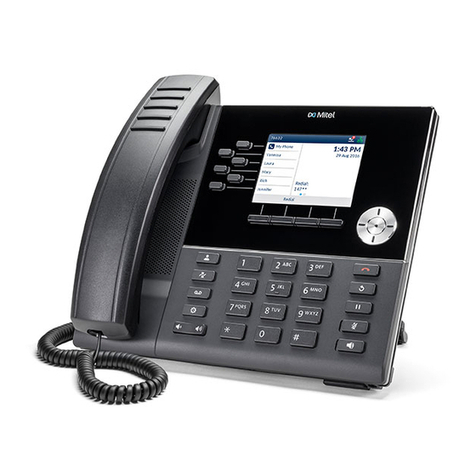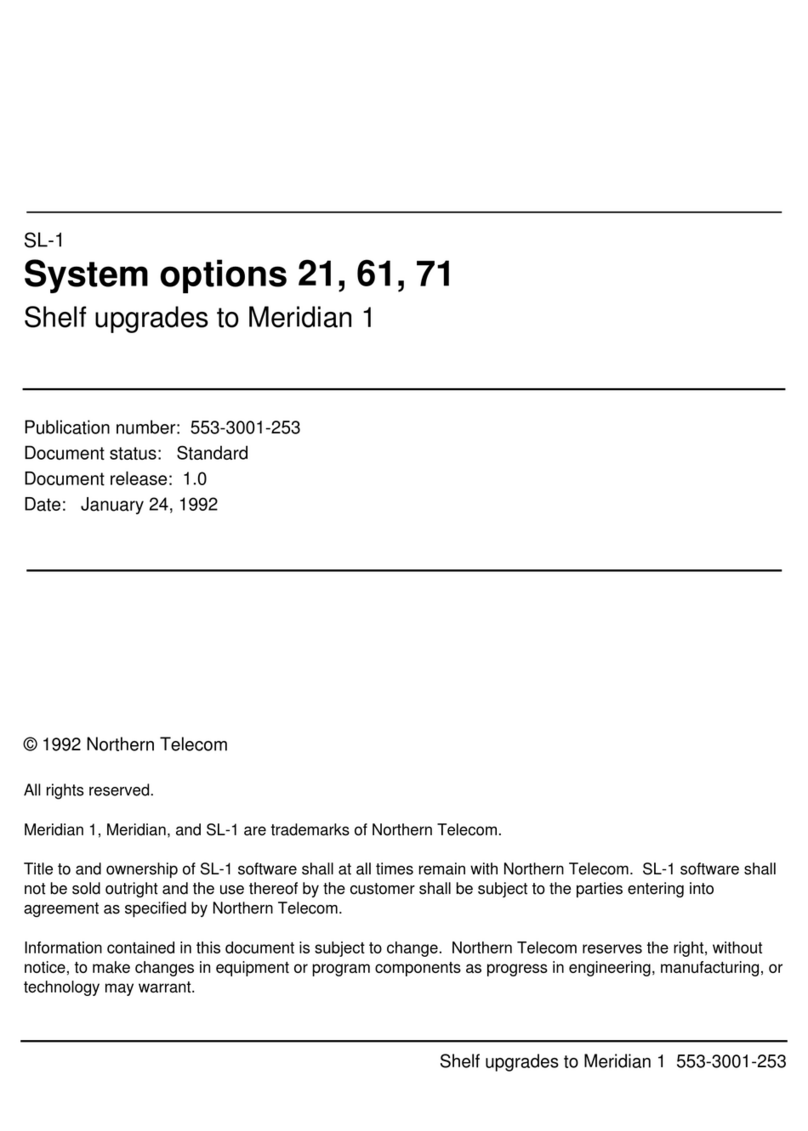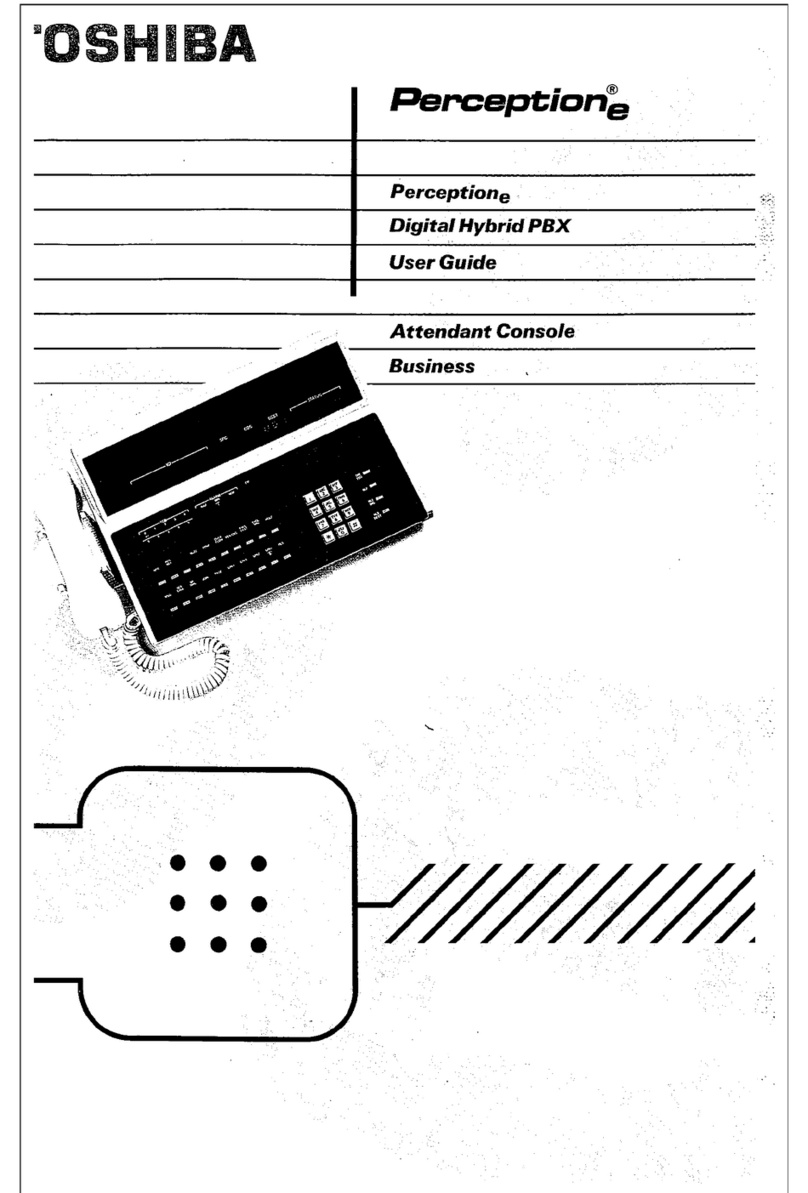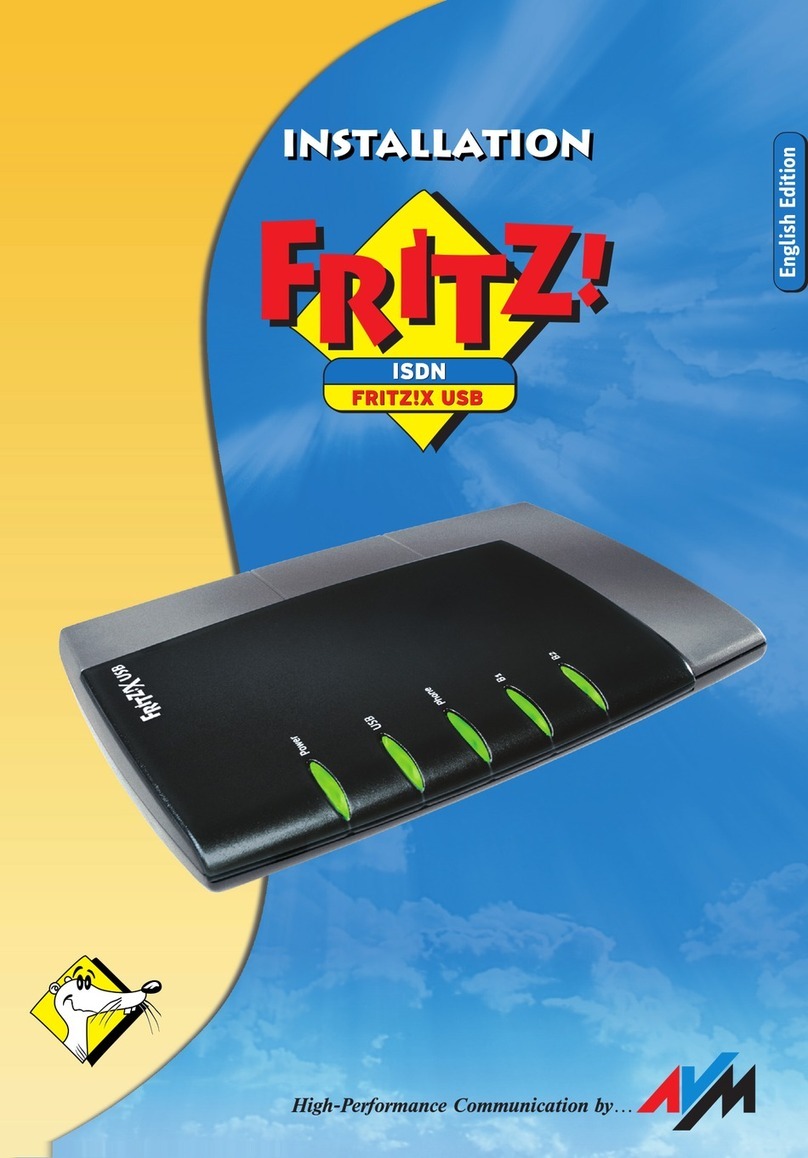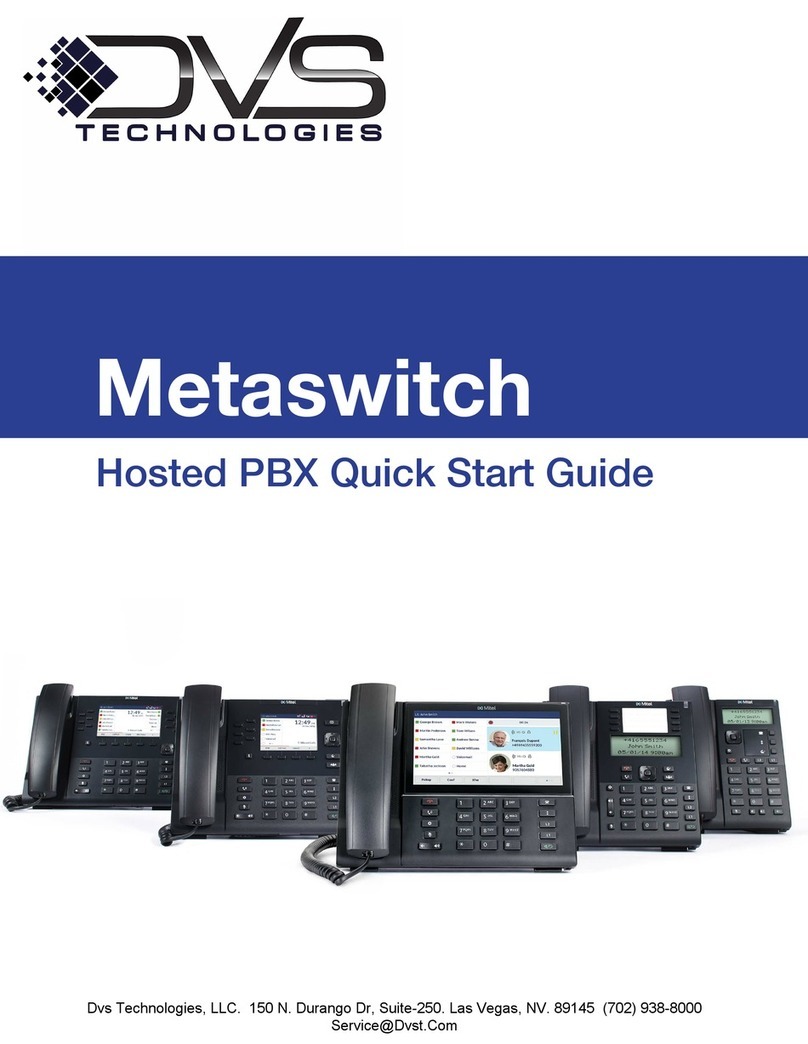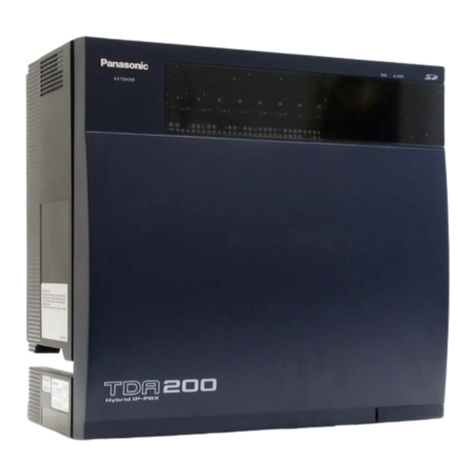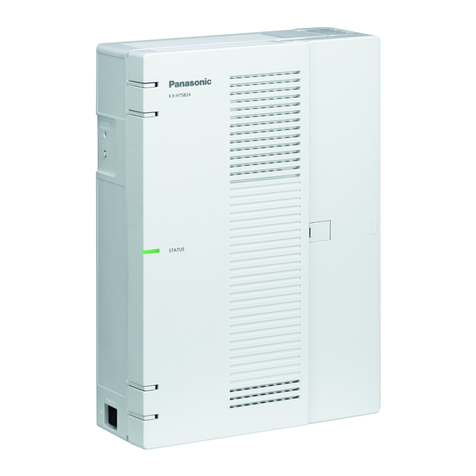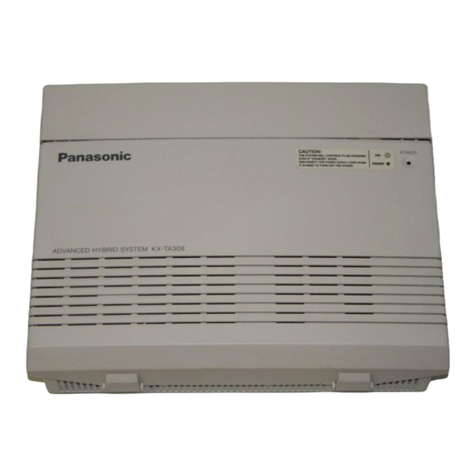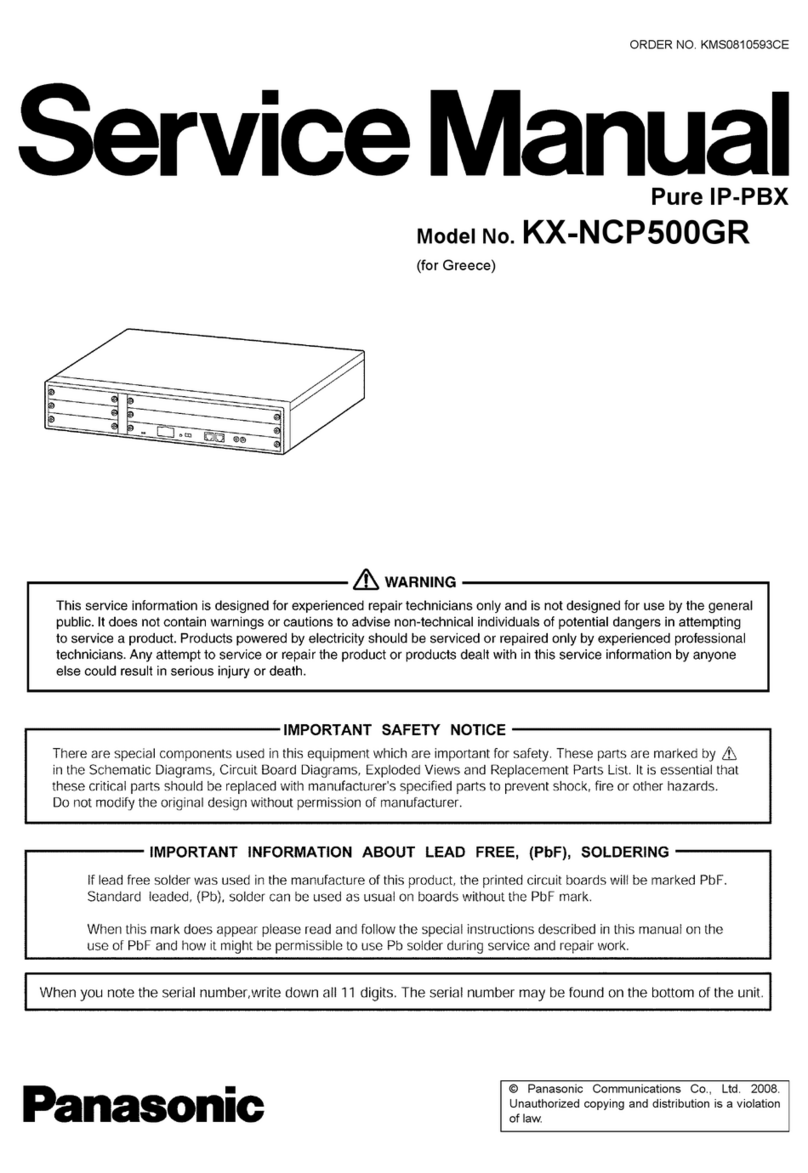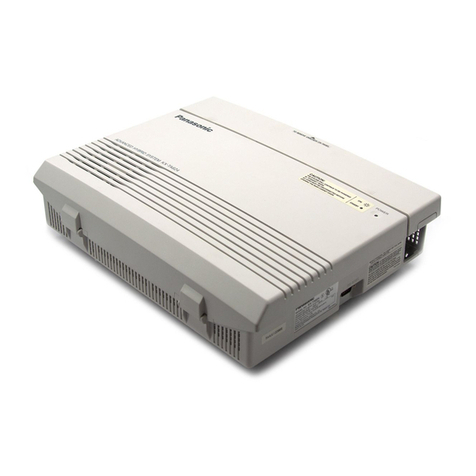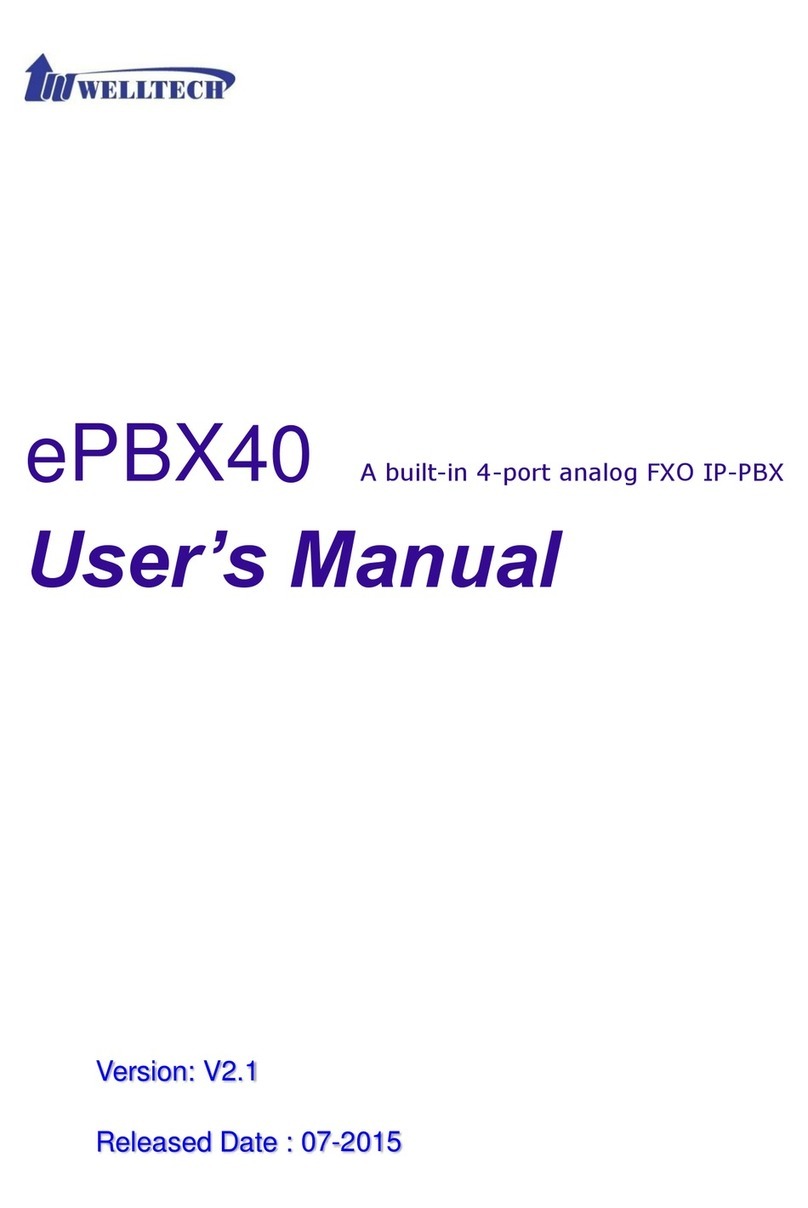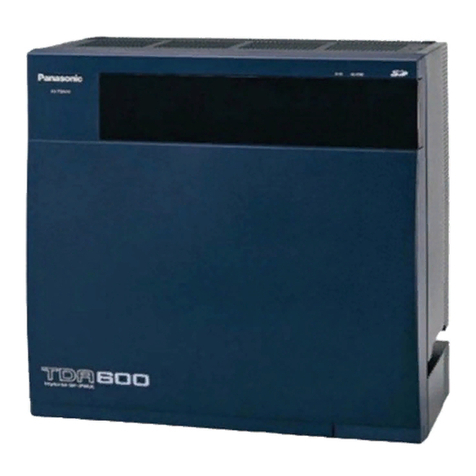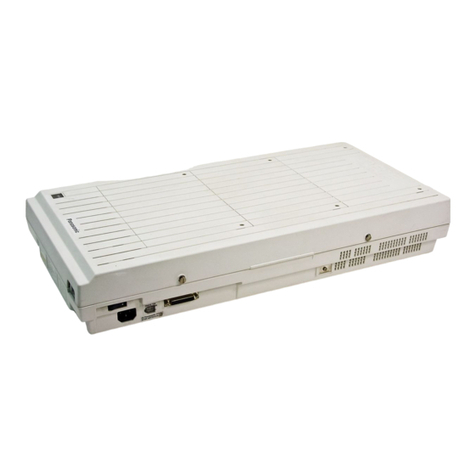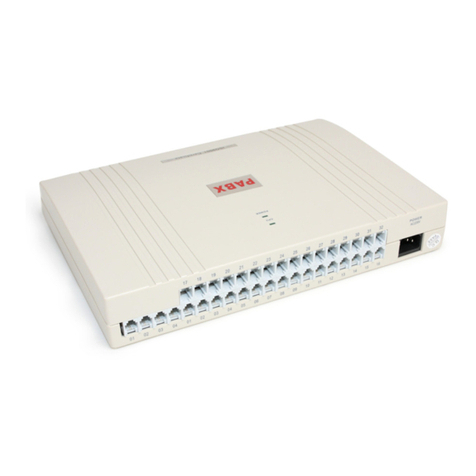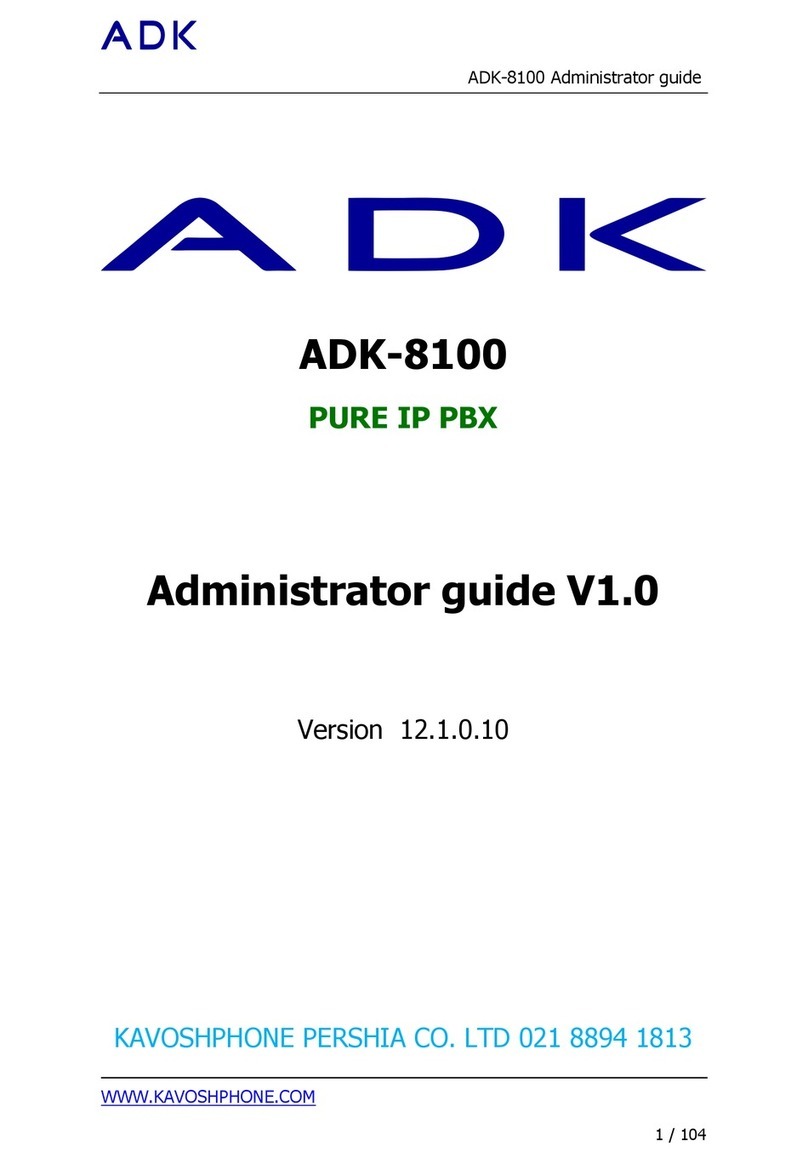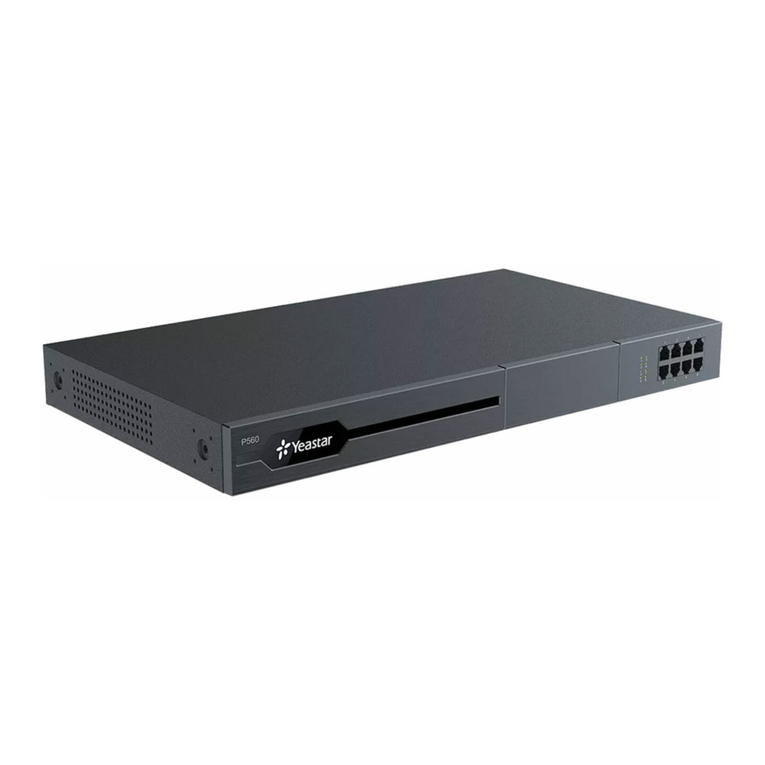Mitel Navigator 3300 ICP Use and care manual

MiVoice Business
Hardware Technical Reference Manual
RELEASE 9.1 SP1
September 2020

Notice
The information contained in this document is believed to be accurate in all respects but is not warranted by Mitel Networks™
Corporation (MITEL®). The information is subject to change without notice and should not be construed in any way as a commit-
ment by Mitel or any of its affiliates or subsidiaries. Mitel and its affiliates and subsidiaries assume no responsibility for any errors
or omissions in this document. Revisions of this document or new editions of it may be issued to incorporate such changes.No
part of this document can be reproduced or transmitted in any form or by any means - electronic or mechanical - for any purpose
without written permission from Mitel Networks Corporation.
Trademarks
The trademarks, service marks, logos and graphics (collectively “Trademarks”) appearing on Mitel's Internet sites or in its publi-
cations are registered and unregistered trademarks of Mitel Networks Corporation (MNC) or its subsidiaries (collectively "Mitel")
or others. Use of the Trademarks is prohibited without the express consent from Mitel. Please contact our legal department at
[email protected] for additional information. For a list of the worldwide Mitel Networks Corporation registered trademarks, please
refer to the website: http://www.mitel.com/trademarks.
®,™ Trademark of Mitel Networks Corporation
© Copyright 2020, Mitel Networks Corporation
All rights reserved

Contents
Chapter: 1 Introduction . . . . . . . . . . . . . . . . . . . . . . . . . . . . . . . . . 1
About this Guide . . . . . . . . . . . . . . . . . . . . . . . . . . . . . . . 1
What’s new . . . . . . . . . . . . . . . . . . . . . . . . . . . . . . . . . . 1
Important Safety Instructions . . . . . . . . . . . . . . . . . . . . . . . . 2
3300 ICP Overview . . . . . . . . . . . . . . . . . . . . . . . . . . 2
New Hardware . . . . . . . . . . . . . . . . . . . . . . . . . . . . . . . . 3
Mitel MiVoice Business Release 9.1 . . . . . . . . . . . . . . . . 3
MXe III-L Controller . . . . . . . . . . . . . . . . . . . . . . . . . 3
Supporting Documentation . . . . . . . . . . . . . . . . . . . . . 3
Chapter: 2 3300 ICP Controllers . . . . . . . . . . . . . . . . . . . . . . . . . . . . . 4
Description . . . . . . . . . . . . . . . . . . . . . . . . . . . . . . . . . . 4
Controller Types . . . . . . . . . . . . . . . . . . . . . . . . . . . . . . . 4
Optional Components . . . . . . . . . . . . . . . . . . . . . . . . 4
AX Controller . . . . . . . . . . . . . . . . . . . . . . . . . . . . . . . . . 5
Standard Configuration for AX . . . . . . . . . . . . . . . . . . . 7
Optional Configuration . . . . . . . . . . . . . . . . . . . . . . . . 7
MXe Controller . . . . . . . . . . . . . . . . . . . . . . . . . . . . . . . . 8
Standard Configuration for MXe . . . . . . . . . . . . . . . . . .10
Optional Configuration . . . . . . . . . . . . . . . . . . . . . . . .10
CX II and CXi II Controllers . . . . . . . . . . . . . . . . . . . . . . . . . .11
10/100 802.3af LAN Ports (CXi II) . . . . . . . . . . . . . . . . . .12
Front View - CX(i) I I Controllers . . . . . . . . . . . . . . . . . .12
Rear View - CX(i) II Controllers . . . . . . . . . . . . . . . . . . .12
Standard Configuration for CXi II . . . . . . . . . . . . . . . . . .13
Optional Configuration . . . . . . . . . . . . . . . . . . . . . . . .13
Connections . . . . . . . . . . . . . . . . . . . . . . . . . . . . . . . . . .14
Controller Interface . . . . . . . . . . . . . . . . . . . . . . . . .14
RS-232 Ports (Printer and Maintenance) . . . . . . . . . . . . . .14
Copper Interface (Embedded and MMC) Ports . . . . . . . . . .15
Ethernet ports . . . . . . . . . . . . . . . . . . . . . . . . . . . .15
Alarm Port . . . . . . . . . . . . . . . . . . . . . . . . . . . . . .16

Field Upgradeable and Replaceable Controller Modules (AX, MXe, CXi II) 16
Stratum 3 Clock Module . . . . . . . . . . . . . . . . . . . . . . .18
Description . . . . . . . . . . . . . . . . . . . . . . . . . . . . . . . . . . . . . . . . . . . 18
MXe Processor (E2T/RTC) . . . . . . . . . . . . . . . . . . . . . .18
Digital Signal Processor Modules . . . . . . . . . . . . . . . . . .18
Quad DSP MMC . . . . . . . . . . . . . . . . . . . . . . . . . . . . . . . . . . . . . . . 18
DSP II MMC . . . . . . . . . . . . . . . . . . . . . . . . . . . . . . . . . . . . . . . . . . 19
Echo Canceller Module . . . . . . . . . . . . . . . . . . . . . . .19
Quad Copper Interface Module (CIM) . . . . . . . . . . . . . . .19
Description . . . . . . . . . . . . . . . . . . . . . . . . . . . . . . . . . . . . . . . . . . . 19
Specifications . . . . . . . . . . . . . . . . . . . . . . . . . . . . . . . . . . . . . . . . . 20
Dual T1/E1 Framer . . . . . . . . . . . . . . . . . . . . . . . . . .20
Description . . . . . . . . . . . . . . . . . . . . . . . . . . . . . . . . . . . . . . . . . . 20
Specifications . . . . . . . . . . . . . . . . . . . . . . . . . . . . . . . . . . . . . . . . . 21
Pin Allocations . . . . . . . . . . . . . . . . . . . . . . . . . . . . . . . . . . . . . . . . 22
T1/E1 Combo Card . . . . . . . . . . . . . . . . . . . . . . . . . .22
Description . . . . . . . . . . . . . . . . . . . . . . . . . . . . . . . . . . . . . . . . . . . 22
Specifications . . . . . . . . . . . . . . . . . . . . . . . . . . . . . . . . . . . . . . . . . 23
Pin Allocations . . . . . . . . . . . . . . . . . . . . . . . . . . . . . . . . . . . . . . . . 23
Quad Basic Rate Interface (BRI) Framer . . . . . . . . . . . . . .24
Description . . . . . . . . . . . . . . . . . . . . . . . . . . . . . . . . . . . . . . . . . . 24
Specifications . . . . . . . . . . . . . . . . . . . . . . . . . . . . . . . . . . . . . . . . . 25
Pin Allocations . . . . . . . . . . . . . . . . . . . . . . . . . . . . . . . . . . . . . . . . 25
AX and ASU II Specific Modules . . . . . . . . . . . . . . . . . . .25
Analog Line Cards (for AX and ASU II only) . . . . . . . . . . . . . . . . 25
AX/ASU II Specifications . . . . . . . . . . . . . . . . . . . . . . . . . . . . . . . . 26
Analog Boards . . . . . . . . . . . . . . . . . . . . . . . . . . . .28
Analog Main Board/Analog Option Board . . . . . . . . . . . . . . . . . 28
Specifications . . . . . . . . . . . . . . . . . . . . . . . . . . . . . . . . . . . . . . . . . 31
Recommendations for North American LS Trunks . . . . . . . . . . . 34
Recommendations for UK LS Trunks . . . . . . . . . . . . . . . . . . . . . . 34
LS Trunk Impedance Characteristics . . . . . . . . . . . . . . . . . . . . . . 34
Music on Hold and Paging Specifications . . . . . . . . . . . . . .40
Music On Hold . . . . . . . . . . . . . . . . . . . . . . . . . . . . . . . . . . . . . . . . 40
Paging . . . . . . . . . . . . . . . . . . . . . . . . . . . . . . . . . . . . . . . . . . . . . . . 40
Pin Allocations . . . . . . . . . . . . . . . . . . . . . . . . . . . . . . . . . . . . . . . . 40
Chapter: 3 Services Units and Gateways . . . . . . . . . . . . . . . . . . . . . . . 43
Analog Services Units . . . . . . . . . . . . . . . . . . . . . . . . . . . . .43
Description . . . . . . . . . . . . . . . . . . . . . . . . . . . . . .43
Analog Services Unit II (ASU II) . . . . . . . . . . . . . . . . . . .43
Analog Services Unit . . . . . . . . . . . . . . . . . . . . . . . . .44
Universal Analog Services Unit . . . . . . . . . . . . . . . . . . .45
Music On Hold (Universal ASU only) . . . . . . . . . . . . . . . . . . . . . . 46
Paging (Universal ASU only) . . . . . . . . . . . . . . . . . . . . . . . . . . . . . 47
ASU II Transmission Standards . . . . . . . . . . . . . . . . . . . . . . . .48

Circuit Descriptions . . . . . . . . . . . . . . . . . . . . . . . . . . . . . .48
On-Premise Station Lines . . . . . . . . . . . . . . . . . . . . . .48
Loop Start Trunks . . . . . . . . . . . . . . . . . . . . . . . . . . .50
System Fail Transfer (SFT) . . . . . . . . . . . . . . . . . . . . . .51
Pin Allocations . . . . . . . . . . . . . . . . . . . . . . . . . . . . . . . . .52
ASU II Line and Trunk Connector . . . . . . . . . . . . . . . . . .52
ASU and Universal ASU Line and Trunk Connector . . . . . . . .53
CIM Port . . . . . . . . . . . . . . . . . . . . . . . . . . . . . . . . . . . . . . . . . . . . . 55
ASU II ONS Parameters . . . . . . . . . . . . . . . . . . . . . . .55
ASU and Universal ASU ONS Parameters . . . . . . . . . . . . . .55
ONS Transmission Parameters . . . . . . . . . . . . . . . . . . . . . . . . . . . 55
ONS DC Supervision Parameters . . . . . . . . . . . . . . . . . . . . . . . . . 56
ONS Ringing Parameters . . . . . . . . . . . . . . . . . . . . . . . . . . . . . . . . 56
ONS Message Waiting Parameters . . . . . . . . . . . . . . . . . . . . . . . 56
ASU II LS Trunk Parameters . . . . . . . . . . . . . . . . . . . . .57
ASU II LS Trunk Parameters . . . . . . . . . . . . . . . . . . . . .57
LS Trunks Selection in the UK . . . . . . . . . . . . . . . . . . . .58
LS Trunks, Acceptable Noise Levels . . . . . . . . . . . . . . . . .58
Digital Service Unit . . . . . . . . . . . . . . . . . . . . . . . . . . . . . .60
SUPERSET HUB . . . . . . . . . . . . . . . . . . . . . . . . . . . .60
Chapter: 4 Specifications . . . . . . . . . . . . . . . . . . . . . . . . . . . . . . . 61
Environment . . . . . . . . . . . . . . . . . . . . . . . . . . . . . . . . . .61
Controller . . . . . . . . . . . . . . . . . . . . . . . . . . . . . . . . . . .61
Services Units . . . . . . . . . . . . . . . . . . . . . . . . . . . . . . . . .62
Dimensions . . . . . . . . . . . . . . . . . . . . . . . . . . . . . . . . . .62
Controller . . . . . . . . . . . . . . . . . . . . . . . . . . . . . .62
Services Units . . . . . . . . . . . . . . . . . . . . . . . . . . . . .63
Power . . . . . . . . . . . . . . . . . . . . . . . . . . . . . . . . . . . . .63
Controllers . . . . . . . . . . . . . . . . . . . . . . . . . . . . . .63
Analog Services Units (ASU) . . . . . . . . . . . . . . . . . . . . .64
Telephone Power . . . . . . . . . . . . . . . . . . . . . . . . . . . . . . .64
CXi II Power over Ethernet (PoE) . . . . . . . . . . . . . . . . . .64
3300 Power Dongle (Cisco compliant) . . . . . . . . . . . . . . .65
Cisco Switches . . . . . . . . . . . . . . . . . . . . . . . . . . . . . . . . . . . . . . . . 65
HP ProCurve Products . . . . . . . . . . . . . . . . . . . . . . . .66
HP ProCurve 5300 with Expandable 10/100 PoE Modules . . . . 66
HP ProCurve 2600-PWR Series . . . . . . . . . . . . . . . . . . . . . . . . . . . 66
Hardware Interface Comparison of EX with other 3300 ICP Controllers .67
Chapter: 5 Appendix A : Signaling, Tones, and Transmission . . . . . . . . . . . . 69
Signaling and Supervisory Tones . . . . . . . . . . . . . . . . . . . . . .69
Time-Out Information . . . . . . . . . . . . . . . . . . . . . . . . . . . .69
Transmission Characteristics . . . . . . . . . . . . . . . . . . . . . . . . .70
Compliances . . . . . . . . . . . . . . . . . . . . . . . . . . . . .71

Line and Trunk Support Characteristics (North America) . . . . .71
Loss Plan Matrices . . . . . . . . . . . . . . . . . . . . . . . . . . . . . .71
Port Abbreviations . . . . . . . . . . . . . . . . . . . . . . . . . .71
Station Circuits . . . . . . . . . . . . . . . . . . . . . . . . . . . . . . . . . . . . . . . 72
Trunk Circuits . . . . . . . . . . . . . . . . . . . . . . . . . . . . . . . . . . . . . . . . . 73
Australia . . . . . . . . . . . . . . . . . . . . . . . . . . . . . . . . . . . . . . . . . . . . . 74
Brazil . . . . . . . . . . . . . . . . . . . . . . . . . . . . . . . . . . . . . . . . . . . . . . . . 76
China . . . . . . . . . . . . . . . . . . . . . . . . . . . . . . . . . . . . . . . . . . . . . . . 77
France . . . . . . . . . . . . . . . . . . . . . . . . . . . . . . . . . . . . . . . . . . . . . . . 79
Germany . . . . . . . . . . . . . . . . . . . . . . . . . . . . . . . . . . . . . . . . . . . . 80
Italy . . . . . . . . . . . . . . . . . . . . . . . . . . . . . . . . . . . . . . . . . . . . . . . . . 81
Latin America . . . . . . . . . . . . . . . . . . . . . . . . . . . . . . . . . . . . . . . . . 83
Netherlands . . . . . . . . . . . . . . . . . . . . . . . . . . . . . . . . . . . . . . . . . . 84
New Zealand . . . . . . . . . . . . . . . . . . . . . . . . . . . . . . . . . . . . . . . . . 85
North America . . . . . . . . . . . . . . . . . . . . . . . . . . . . . . . . . . . . . . . . 87
Portugal . . . . . . . . . . . . . . . . . . . . . . . . . . . . . . . . . . . . . . . . . . . . . 88
Spain . . . . . . . . . . . . . . . . . . . . . . . . . . . . . . . . . . . . . . . . . . . . . . . . 89
United Kingdom . . . . . . . . . . . . . . . . . . . . . . . . . . . . . . . . . . . . . . 90
Tone Plans . . . . . . . . . . . . . . . . . . . . . . . . . . . . . . . . . . .92
Australia . . . . . . . . . . . . . . . . . . . . . . . . . . . . . . . .92
Brazil . . . . . . . . . . . . . . . . . . . . . . . . . . . . . . . . . .94
China . . . . . . . . . . . . . . . . . . . . . . . . . . . . . . . . .97
France . . . . . . . . . . . . . . . . . . . . . . . . . . . . . . . . .99
Germany . . . . . . . . . . . . . . . . . . . . . . . . . . . . . . 101
Italy . . . . . . . . . . . . . . . . . . . . . . . . . . . . . . . . . 104
Latin America . . . . . . . . . . . . . . . . . . . . . . . . . . . . 106
Netherlands . . . . . . . . . . . . . . . . . . . . . . . . . . . . . 109
New Zealand . . . . . . . . . . . . . . . . . . . . . . . . . . . . 111
North America . . . . . . . . . . . . . . . . . . . . . . . . . . . 114
Portugal . . . . . . . . . . . . . . . . . . . . . . . . . . . . . . . 116
Spain . . . . . . . . . . . . . . . . . . . . . . . . . . . . . . . . . 119
United Kingdom . . . . . . . . . . . . . . . . . . . . . . . . . . 122
Chapter: 6 Appendix B : Ethernet Cabling Guidelines . . . . . . . . . . . . . . . .125
Introduction . . . . . . . . . . . . . . . . . . . . . . . . . . . . . . . . . 125
Maximum Cable Lengths . . . . . . . . . . . . . . . . . . . . . . . . . . 125
Cabling Guidelines for the Desktop . . . . . . . . . . . . . . . . . . . . 125
Cabling Guidelines in the Equipment Room . . . . . . . . . . . . . . . 127
Category 3 Cabling Guidelines (CXi II) . . . . . . . . . . . . . . . . . . 132

1
ABOUT THIS GUIDE
CHAPTER 1 INTRODUCTION
Introduction
About this Guide
The Hardware Technical Reference Manual provides technical information for Mitel ® 3300 IP Communi-
cations Platform (ICP) hardware and supported peripherals. It covers hardware descriptions, specifica-
tions, and signaling parameters. This manual is intended for use by qualified technicians and system
engineers planning an installation of the 3300 ICP system.
NOTE: For information on EX Controller, see EX Controller Installation and Administration Guide.
What’s new
Table 1.1: Issue 1.0 (Sheet 1 of 2)
Feature/Enhancement Document Update Location
Interface comparison
between EX and other
3300 ICP Controllers
Added a table, comparing the
hardware interface of EX with
other 3300 ICP Controllers.
Hardware Interface
Comparison of EX with
other 3300 ICP
Controllers

2
IMPORTANT SAFETY INSTRUCTIONS
CHAPTER 1 INTRODUCTION
Important Safety Instructions
WARNING: Before attempting installation, read the 3300 ICP Safety Instructions available on the Mitel
Customer Documentation web site.
WARNING: Failure to follow all instructions may result in improper equipment operation and/or risk of elec-
trical shock.
3300 ICP Overview
The Mitel 3300 ICP is a converged Voice over IP (VoIP) solution that manages calls from IP devices
connected to an IP network and from TDM (time division multiplexing) devices on existing telephony
New Controller: MXe III-L The MXe III-L (L = LAN) 3300 ICP
controller is introduced to replace
the MXe III because controller
parts for the latter are no longer
available.
The MXe III-L controller requires
MiVoice Business Release 9.1 or
later.The MXe III-L controller uses
the same RTC/E2T compute
cards and MMC cards that the
MXe III controller supports with
MiVoice Business 9.1; the
performance of the MXe III-L
controller is the same as the MXe
III controller.
The MXe III-L controller is different
from the MXe III controller in the
following ways:
•No WAN support
•No LAN Port 2 support
•No L2 redundancy
•No IGMP filtering
•No 1G Ethernet speed for LAN
port
Global
The MXe III-L controller supports
MiVoice Business 9.1 or later only.
If you have to replace your MXe III
controller with an MXe III-L
controller, follow the instructions in
KMS article S05142.
Table 1.1: Issue 1.0 (Continued) (Sheet 2 of 2)
Feature/Enhancement Document Update Location

3
NEW HARDWARE
CHAPTER 1 INTRODUCTION
networks. The 3300 ICP controller provides IP and TDM call processing. The 3300 ICP system may also
include Analog Services Units and peripheral cabinets to provide connectivity for analog and digital trunks
and telephones.
New Hardware
Mitel MiVoice Business Release 9.1
The AX controller now requires a single 16 GB Compact Flash (CF) for the system software, database,
and embedded voice mail, instead of the 2 GB/4 GB CF combo in pre-9.0 release. See Standard Config-
uration for AX.
MXe III-L Controller
The MXe III-L (L = LAN) controller was developed because some hardware parts of the MXe III controller
will no longer be available.
The MXe III-L controller supports MiVoice Business 9.1 and later only. The MXe III-L controller will be
available in Q1, 2020 only for the following regions: North America, UK, Middle East, Africa, Australia, and
New Zealand.
The MXe III-L controller uses the same RTC/E2T compute cards and MMC cards that the MXe III supports
with MiVoice Business 9.1; the performance of the MXe III-L controller is the same as the MXe III
controller.
The MXe III-L controller is different from the MXe III controller in the following ways:
•No WAN support
•No LAN Port 2 support
•No L2 redundancy
•No IGMP filtering
•No 1G Ethernet speed for LAN port
If you have to replace your MXe III controller with an MXe III-L controller, follow the instructions in KMS
article S05142.
Supporting Documentation
Refer to Mitel OnLine for Customer Documentation and Knowledge Base Articles.

4
DESCRIPTION
CHAPTER 2 3300 ICP CONTROLLERS
3300 ICP Controllers
Description
The 3300 ICP Controller contains the logic, processor, memory, communication interfaces, and call
control software for managing call processing on the system.
NOTE: Refer to the 3300 ICP Release 7.0 version of the Hardware Technical Reference Manual for details
on the older controllers; 100-user, 250/700-user, LX and MX.
Controller Types
•AX Controller
•MXe Controller
•CX II and CXi II Controllers
The Controller consists of the following main components:
• Real Time Complex (RTC): stores Call Control software and provides main control
• Ethernet to TDM (E2T): converts Time Division Multiplex voice streams to IP packets.
• Mid-plane: a circuit board that holds functional circuit blocks such as Ethernet devices and LEDs
• Echo Canceller: provides echo cancellation on IP calls.
• Quad Digital Signal Processor (DSP): provides telecom functions and G.279 compression
• Hard Disk (CXi II/MXe) : stores database, configuration data, and embedded voicemail.
•Compact Flash (AX) : stores database, configuration data.
•System i-Button: contains a unique serial number that identifies the controller for licensing purposes.
•Firewall (CXi/MXe excluding MXe III-L): secures the WAN port against unauthorized access by drop-
ping or rejecting unknown packets, allowing or disallowing IPSec and PPTP pass-through, and
performing many-to-1NAT (IP masquerading)
The WAN port and firewall in the CXi and MXe (excluding MXe III-L) is intended to be used either as
an access point for performing remote diagnostics and maintenance (similar to a MODEM) or, if the
Firewall function is disabled, as internal router to transparently route packets between the WAN port
and the controller's LAN ports.
NOTE: The WAN port and internal firewall should only be used as a network router in situations
where the amount of internet access is very low. For most installations, the Administrator should
employ a dedicated internet router/firewall.
• Stratum 3 Clock: provides synchronization for digital connections to external networks.
• Power supply: supplies power to the controller
Optional Components
The following modules can be installed to increase capacity, expand functionality or improve reliability
(see Field Upgradable and Replaceable Controller Modules):
•Quad Digital Signal Processor (DSP) Mitel Mezzanine Card (MMC)

5
AX CONTROLLER
CHAPTER 2 3300 ICP CONTROLLERS
•DSP II MMC
•Echo Canceller Module
•Quad CIM (Copper Interface Module) MMC
•Dual Fiber Interface Module (FIM) MMC
•4 + 12 port combo card and 24 port ONS card (AX)
•Dual T1/E1 Framer MMC
•T1/E1 Combo Card
•Quad BRI Framer MMC
•Analog Main Board (AMB)/Analog Option Board (AOB) (CX(i) II controllers only)
•RAID controller and additional hard drive
•Redundant power supply
AX Controller
The AX controller is ideal where a high density of analog devices is required. There are two typical system
configurations, standalone and networked, although as with any system, these functions may be mixed.
•The AX supports up to 48 T1 or 60 E1 on-board digital trunks, up to 112 IP phones, and 288 analog
phones (maximum 400 devices).
•The AX controller will support a second AC Power Supply Unit.
Figure 2.1: AX Controller
The controller front panel consists of the following components:

6
AX CONTROLLER
CHAPTER 2 3300 ICP CONTROLLERS
•System LEDs - Alarm, Flash Activity, Power/Status
Figure 2.2: AX Controller Front View (Cover Removed)
The controller card in the AX controller rear panel consists of the following components:
•One slot for expansion modules
•Two 10/100 BaseT Ethernet LAN ports (RJ-45 connector)
•One DB-9 maintenance port

7
AX CONTROLLER
CHAPTER 2 3300 ICP CONTROLLERS
•System LEDs - Alarm, Flash Activity, Power/Status
Figure 2.3: AX Controller Rear View
The controller rear panel consists of the following components:
•One or two power supply units
•Fan complex
•Controller card (described above)
•12 line card slots
•Protective ground
Standard Configuration for AX
•One 450 MHz processor for combined RTC and E2T functionality
•4 embedded DSP resources
•16 GB flash card for system software, database, and embedded voice mail
•512 MB of RAM
Optional Configuration
You can add

8
MXE CONTROLLER
CHAPTER 2 3300 ICP CONTROLLERS
•24 port ONS line card (up to 12)
•16 port ONS line card (up to 12)
•4 + 12 port combo card (up to 12)
•Quad DSP MMC or octal DSP II MMC
•Dual T1/E1 MMC
•T1/E1 Combo MMC
•Dual FIM
•Quad BRI MMC
•128 channel Echo Canceller
•Second AC Power Supply for redundant power
You can also replace the 2-GByte flash card with a 4-GByte flash card to support more than 65,000 RDNs.
MXe Controller
•The MX Expandable controller supports 300 to 1400 (expanded version) users and 350 to 1500
devices.
•The MXe controller ships with one 540 MHz RTC processor and embedded DSP resources (equivalent
to three Quad DSP modules), a hard drive, and an Analog Main Board (AMB).
•The MXe controller can be upgraded with the addition of a second processor, E2T, to increase
capacity.
•Redundancy is available with the addition of a RAID controller, a second hard disk, and a second AC
PSU.
Figure 2.4: MXe Controller Front View

9
MXE CONTROLLER
CHAPTER 2 3300 ICP CONTROLLERS
Figure 2.5: MXe III-L Controller Front View
The controller front panel consists of the following components:
•Six slots for expansion modules (two internal)
•Alarm port
•Two DB-9 ports, both connected to the RTC, for maintenance and printer connection
•Two 10/100/1G BaseT Ethernet LAN ports (RJ-45 connector)
NOTE: 1G BaseT Ethernet LAN Ports are not supported on MXe III-L controllers.
•One 10/100 BaseT Ethernet WAN port (RJ-45 connector) with built-in firewall
The WAN port and firewall is intended to be used either as an access point for performing remote di-
agnostics and maintenance (similar to a MODEM) or, if the Firewall function is disabled, as internal
router to transparently route packets between the WAN port and the controller's LAN ports.
NOTE: The WAN port is not supported on MXe III-L controllers.
NOTE: The WAN port and internal firewall should only be used as a network router in situations
where the amount of internet access is very low. For most installations, the Administrator should
employ a dedicated internet router/firewall.
•Four CIM ports
•Remote alarms on/off
•System LEDs - Alarm, Hard Drive, Power/Status
•Status LEDs - Ethernet, CIM, and Alarm
•Reset button.

10
MXE CONTROLLER
CHAPTER 2 3300 ICP CONTROLLERS
Figure 2.6: MXe Controller Rear View
Figure 2.7: MXe Controller with Redundant Hard Drive and Power Supply - Rear View
The rear panel has an input power connector (standard male IEC320 AC) and protective ground.
Standard Configuration for MXe
•Six slots for expansion modules
•RTC / E2T compute card:
–On MXe III (Release MCD 4.2 and later): MPC8360 533 MHz processor with 512 MB of DDR
–On MXe: MPC8280 450 MHz processor with 512 MB of SDRAM
–On MXe III-L: MPC8360 533 MHz processor with 1GB of DDR
•Mid-plane with 4 21363 DSP and DSP Echo Canceller module included (3300 ICP S/W Rel. 8.0 and
later).
•Stratum 3 clock
•Analog Main Board for embedded analog trunks and lines
•Two (redundant) cooling fans
Optional Configuration
You can add
•E2T Processor Card (MMC-C) with 1 GB RAM (for MXe III and MXe III-L)
•1 GB RAM Module Upgrade (for MXe III only)
•One or two 128-channel Echo Canceller modules
•DSP or DSP II modules for G.729a compression
• DSP II modules for FAX Relay (T.38)

11
CX II AND CXI II CONTROLLERS
CHAPTER 2 3300 ICP CONTROLLERS
•Up to four Dual FIMs for connecting peripheral cabinets, and DSUs (not applicable for MXe III-L
controllers)
•Up to four Dual T1/E1 Framer modules
•Up to four T1/E1 Combo modules
•Up to three Quad BRI Framer modules
•Quad CIM
•RAID (Redundant Array of Independent Disks) module
•Second AC Power Supply for Redundant Power
CX II and CXi II Controllers
The CX(i) II controllers are next-generation versions of the original CX and CXi controllers. Featuring
increased processing power, the CXi II can support up to 150 users and with fewer limitations on resource
(DSP) intensive applications. In fact, the base configuration of the CXi II has all the DSP resources the
system requires. You only need to add more DSP resources for enhanced functionality—for example,
T.38 fax support—not performance scaling. For more information on resource-related improvements to
the CXi II, see the “Engineering Guideline Updates” on page 14. Other key enhancements of and CXi II
include:
•choice of an 8 GB solid state (Flash) drive or a 80 GB spinning drive for mass storage media.
•two 21363 DSPs on the main board providing sufficient resources to support main telephony functions
(tone generation, tone detection, voice mail, record a call, 30-party conference) and 32 channels of
Echo cancellation.
•support for the new Application Processor Card (APC) which offers additional deployment options for
MiCollab solutions.
•redundant fans
The CX(i) II controller front panel consists of the following components:
•Three slots for expansion modules
•DB-9 RS-232 Maintenance Console Port used to access the operating system shell. Also supports
hardware flow control for an external modem. All other directed I/O function such as the virtual printer
port and embedded CPU serial port are accessed through either secure telnet or a TCP/IP socket.
•Dual USB 2.0 ports (for future use)
•CXi II only; 10/100 BaseT WAN port (RJ-45 connector) with built-in firewall
The WAN port and firewall is intended to be used either as an access point for performing remote di-
agnostics and maintenance (similar to a MODEM) or, if the Firewall function is disabled, as internal
router to transparently route packets between the WAN port and the controller's LAN ports.
NOTE: The WAN port and internal firewall should only be used as a network router in situations
where the amount of internet access is very low. For most installations, the Administrator should
employ a dedicated internet router/firewall.
•CXi II only; 10/100/1000 BaseT LAN port (RJ-45 connector)
•CXi II only; 16 10/100 BaseT 802.3af LAN ports connected to an internal Ethernet Layer 2 switch.
•Reset button
NOTE: The Reset button, resets the Ethernet/POE module and the main processor.
•Status LEDs - Power, media access, and alarm

12
CX II AND CXI II CONTROLLERS
CHAPTER 2 3300 ICP CONTROLLERS
10/100 802.3af LAN Ports (CXi II)
The CXi II includes a 16-port managed Layer 2 Ethernet switch. Each port supports auto-negotiation and
is able to connect to 10Base-T or 100Base-TX devices and determine the appropriate data rate from infor-
mation provided to it. Duplex mode and flow control are also programmable for each port. The ports use
8-way RJ-45 connectors that conform to Category 5 wiring standards. Although CAT5 cabling is recom-
mended, Category 3 can be used for limited installations. Refer to Appendix A and the Engineering Guide-
lines for CAT3 Cabling details.
The 16 ports comply with the 802.3af Power over Ethernet specification, which enables them to deliver
power to IP phones and other Ethernet devices over Category 3 or 5 cabling. As a minimum, the PoE
module provides enough power for 16 IP phones, some of which may be fitted with PKMs. For details
about PoE and planning a PoE installation, see the Engineering Guidelines on the Mitel Edocs web site
(http://edocs.mitel.com).
The internal switch uses 802.1p/Q VLAN prioritization to ensure the quality of voice calls, forwarding
packets with priority value 6 (from IP phones) ahead of packets with priority value 0 (from PCs and other
IP devices). Programming is required only if an expansion switch is connected. Refer to the CXi II Specific
Guidelines in the Engineering Guidelines document.
Front View - CX(i) I I Controllers
Figure 2.8: Front View - CX II Controller
Figure 2.9: Front View - CXi II Controller
Rear View - CX(i) II Controllers
The controller rear panel consists of the following components:
•Input power connector and switch
•Protective ground
•Analog Main Board (AMB). Includes six LS trunk ports with CLASS support (CLASS is available in
North America and Latin American only), four ONS ports, a single Mu-sic-on-Hold port (one source
supported), a single Paging port (one paging zone), and two System Fail Transfer circuits.
•Analog Option Board (optional). Includes six LS trunks ports with CLASS support, four ONS ports, one
System Fail Transfer circuits and one paging circuit.

13
CX II AND CXI II CONTROLLERS
CHAPTER 2 3300 ICP CONTROLLERS
Standard Configuration for CXi II
•One 400 MHz MPC8360E processor
•1 GB of RAM
•Analog Main Board (AMB) for analog trunks and lines
•Embedded L2-PoE Ethernet switch with 16 ports (CXi II only)
•Stratum 3 clock
•Two 21363 DSPs on main board
Mass storage (spinning hard disk drive or solid state drive) is provided in a separately orderable kit. The
kit includes factory-installed Mitel MiVoice Business software.
The standard configuration does not support compression. Compression channels can be added using
the DSP-II card. The DSP II module provides up to 64 G.729 voice compression channels. This module
is also required for T.38 FAX. The DSP II module DOES NOT PROVIDE additional telephone resources
(tone detectors and receivers, voice mail, or conference).
Optional Configuration
You can add
•DSP II module for G.729 voice compression and FAX Relay (T.38)
•One or two T1/E1 Combo cards for digital trunking
•One or two Quad BRI Framer modules
•Analog Option Board (AOB)
•Quad CIM.
Dual or Quad DSP modules are supported but not required as the embedded 21363 DSPs provide suffi-
cient telephony resources .

14
CONNECTIONS
CHAPTER 2 3300 ICP CONTROLLERS
Connections
Controller Interface
RS-232 Ports (Printer and Maintenance)
The two RS-232 ports require male DB-9 connectors. The following table lists the pin signals.
Table 2.1: Controller Interfaces
Connector
Function Type
Quantity
Signals Comments
CX
II/CXi II
MXe
III/MXe
III-L AX
RS-232 (front
panel)
DB-9 1 2 1 Txd, Rxd, (RTS),
(CTS), (DTR),
(CD), DSR, Gnd
(parenthesis
indicates
operational
function,
dependent upon
application)
DCE pinout,
female. 115Kb/s
data rate. Default
setting: 9600
bits/s 8 data bits
No parity bit 1
Stop-bit Txd,
Rxd, Gnd
See Note 1.
SATA 7-pin male 1 1 N/A Internal Hard
Disk Drive or
Solid State Drive
Internal to
controller. Used
to connect
system hard disk
drive or solid
state drive.
10/100 BaseT
Ethernet
8-pin
Mod-jack
1/17 1/2 2 TxP, TxN, RxP,
RxN - (Crossover
DX connections)
User side pinout.
See Note 3
10/100/1000
BaseT
Ethernet
8-pin
Mod-jack
0/1 2/0 0 TxP, TxN, RxP,
RxN - (Crossover
DX connections)
User side pinout
Table 2.2: RS-232 Asynchronous Serial Port Pin Allocation (Sheet 1 of 2)
Pin Number Signal Name Abbreviation
1 Data Carrier Detect DCD
2 Receive Data RXD
3 Transmit Data TXD
Other manuals for Navigator 3300 ICP
6
This manual suits for next models
10
Table of contents
Other Mitel PBX manuals
